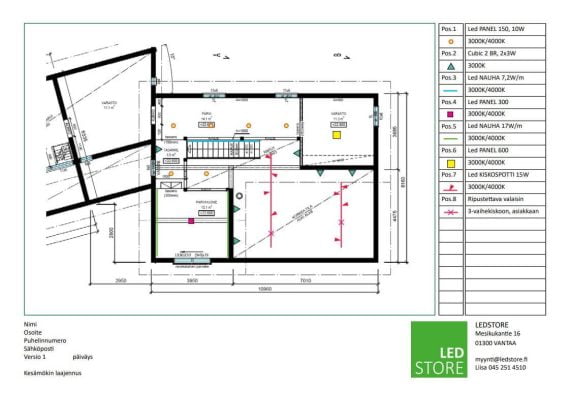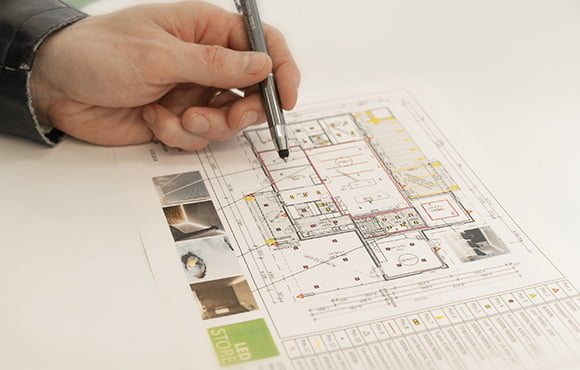Home lighting design is an important part of home renovation or construction, and it’s not a good idea to leave it until the last minute. Few people manage to buy lighting just by walking into an (online) shop and loading up a trolley full of lights.
In this article, we explain what to consider when designing lighting for a detached house, and the benefits of lighting design.
Lighting design for a private house starts with lighting needs
When ordering a lighting design for a private house, it is a good idea to give the designer some background information:
- Is it a new project where there are not so many constraints on the lighting design or a renovation of a detached house where the existing lighting is used as a base and supplemented with new lighting?
- It is important to know if there will be any drop-offs at the site, which will allow, for example, the installation of spotlights.
- How do you want to operate and control the lights?
- What are the light needs of the occupants or users of the space?
- What is the budget for lighting?
- What type of lighting are you looking for? Indirect, spotlight, large light surfaces, etc.
The experience of light is personal, and varies from person to person. Age also affects the need for light and the experience of reflection. It is worth being fair in raising these planning issues at the outset.
What they all have in common is that light is needed to create atmosphere, for working light, and for general lighting. Lighting has a big impact on the experience of a space, such as the atmosphere and usability. With sensible lighting design, lighting can be adaptable without a big budget. It is therefore a good idea to take into account the specificities of the space and to tell us what you want, as each destination is different.
What basic information is required for a successful lighting design for a detached house?
In lighting design, it is important that the designer knows the dimensions of the building, the position of windows and doors, and the layout of the rooms. The best way to make a lighting plan is to see it:
- Floor plan
- Cutaway photos
- Façade images
- Additional benefits include:
- 3D images of the inside and outside of the apartment
- Site plan
- Kitchen, utility room and bathroom furniture photos
- Photographs, if it is a renovation project
The lighting design for a detached house should be carried out before the electrical design, if possible. This saves time for the electrical designer, as there is no need to plan the lighting points. This also makes it easier to achieve the desired lighting.
As a basis for the design, it is also a good idea to go over the lighting-related structures with the designer, such as different ceiling drops and wall structures, so that recessed lighting can be easily implemented. For recessed luminaires, a transverse recess is usually sufficient, which visually lowers the space only slightly compared to the space-reducing effect of, for example, a dark effect wall.

General lighting – using the same type of lighting to give a coherent look to your home
By choosing the same type of lights for general lighting in most rooms, it is easier to achieve uniform lighting in the home and more even light levels from room to room. At this point, choices are made along general lines: whether to go for square or round – panel or spot – metallic, black or white – warm or neutral white (Kelvin) or CCT colour temperature changeable lights and what quality of light is desired (colour rendering index, CRI).
LedStore’s lighting designers have the experience to make recommendations on how to make all spaces fit together and coherent. The height and use of the premises will also be taken into account at this stage.
When renovating, it is a good idea to inform the designer about existing lights that will remain in place. Most people also have their own cherished lights that can easily be retained in lighting design, whether for new or renovated projects.
Design of LED lighting according to the materials, furniture and colours of the home
With good quality lights, the colours of the interior are beautifully presented, and the home is comfortable and safe to live in. Lighting design should take into account the use of space and furniture. Knowing and telling the designer the location of large pieces of furniture makes it easier to plan wall light locations, for example.
When designing the lighting for a detached house, it is also worth considering the colour scheme of the home and discussing colour tones and material choices at a general level, if they are known. For example, reflective, white surfaces need different light from black matte surfaces. Roughly speaking, we recommend using a warm hue (3000 K) with warm colours – such as beige and brown, and a cooler or more neutral hue (4000 K) with cool colours – such as blue-grey and black interior colours. If desired, it is also possible to select CCT colour temperature changeable lighting with colour-temperature controlled lights.
Most often, the colour of lights light is chosen when the construction or renovation work has progressed to the installation stage. We are happy to lend model lights to customers. You can also come to the shop with tiles, wallpaper, etc. with you to compare the colour temperature options.
Lighting of interior details
Spot lighting is a good way to highlight the special features of a space or interior. The LedStore range offers solutions to highlight architectural features, functions or effect walls.
The led strip can be used to easily highlight longer, straight lines and to accentuate lowered ceilings. LED spotlights are also a great way to highlight wall surfaces, art tiles and wallpaper. The LedStore FOKUS spotlight, with its adjustable beam, can also be used for accent lighting of tables and art objects. The adjustment feature makes it easier to project light onto an object.
The lighting design of spot lighting takes into account the need to ensure that other parts of the room are not left dark. When balancing the amount of light, it is an advantage that the lighting designer has a good knowledge of the lights used in the design.
Lighting design for a detached house according to the use of the premises
Different rooms in the home need different amounts of light, and a designer can take this into account. Space-specific design ensures that the amount of light is sufficient for the space and its functions.
Don’t skimp on the amount of light in your workspace – light affects the outcome of your work
For work in kitchens, utility rooms, hobby rooms and home offices, it’s a good idea to design glare-free lighting that allows you to work accurately without squinting. Even good glasses won’t help if there’s too little light. Work is more comfortable, and more efficient, when there is enough light.
People who cook a lot and those who work with colour also appreciate high quality lights with high colour rendering index and better colour rendering. So it’s worth designing high-quality lighting for the spaces where people get dressed and do make-up. In hobbies such as painting, crafting and handicrafts, the colours of the materials you need to see the colour in good quality light, and it’s easier to get a neat and tidy finish.
For example, in a lighting design for a private house, the lighting in a work area is calculated to provide a light power of around 500-800 lux. Our lights are rated in lumens, from which lux (lx) is calculated theoretically by dividing the number of lumens by the area of the space to be lit.
For general lighting in work areas, recessed ceiling lights (plafond and panels) are well suited to achieve uniform and glare-free lighting. In addition, efficient LED strip lighting is most often used to light worktops. A profile-mounted LED strip is attached under of the cabinet allows the light to shine directly to the worktop without creating shadows.
Which rooms in your home should you design dimmable lighting for?
Dimming brings extra comfort to your home. Dimming is most often needed in areas where people spend a lot of time or where a separate dimmable light is needed, especially at night. The use of dimming is popular, and wireless dimmers and receivers allow for versatile use of dimming.
In the living room, dimming is often the most popular, as it is used in both light and dark times. In the evening, it’s nice to create a “twilight hush” by dimming the general lighting.
In bedrooms, dimming makes them more comfortable: dimmer in the evenings and mornings, and brighter when cleaning and tidying up.
In children’s rooms, dimmable lights are in place so that the difference between active and quiet times can also be created by lighting. Combining different types of lights can also create easily adaptable lighting for different situations.
In spa-type washrooms, dimming is popular, so that e.g. relax in the bathtub in dimmer lighting.
In washrooms, it is popular to implement mood lighting with a LED strip, that is installed in the recessed edge of the lowered ceiling. The LED strip can also be used to bring light to the floor level or the bottom of cabinets, making them ideal for use as pathway lights in the dark and providing a nice, cosy glow.
LedStore’s lighting designer knows the products used in the design
Modern LED lighting can easily meet different lighting needs and lighting control, such as dimming. Also gaining in popularity is the ability to adjust the colour of white light from warm white to cool white depending on the situation, known as ‘white balance’. daylight, or the use of effect lighting can be implemented.
Lighting control and automation can be fully managed by, for example, home automation. It is also still possible to use a wired wall button for a single light or a group of luminaires. Flexibility over wired wall buttons is provided by wireless wall buttons and remote controls, as well as mobile control.
So it’s worth taking advantage of lighting design, and talking to a professional before you buy lighting. Planning pays off for both large and small lighting needs. In the LedStore store you can learn about different lighting structures, such as recessed ceilings, batten ceilings and different profile installations.
See also other articles on lighting design:
- Outdoor lighting (link to previous blog)
- Kitchen levels (link to previous blog)
- Nursery lighting (link to previous blog)
- Check out reference and inspiration images of LED lighting (Reference Sites folder on the LedStore blog)
Find out more about lighting design for a detached house and submit a design request online:

